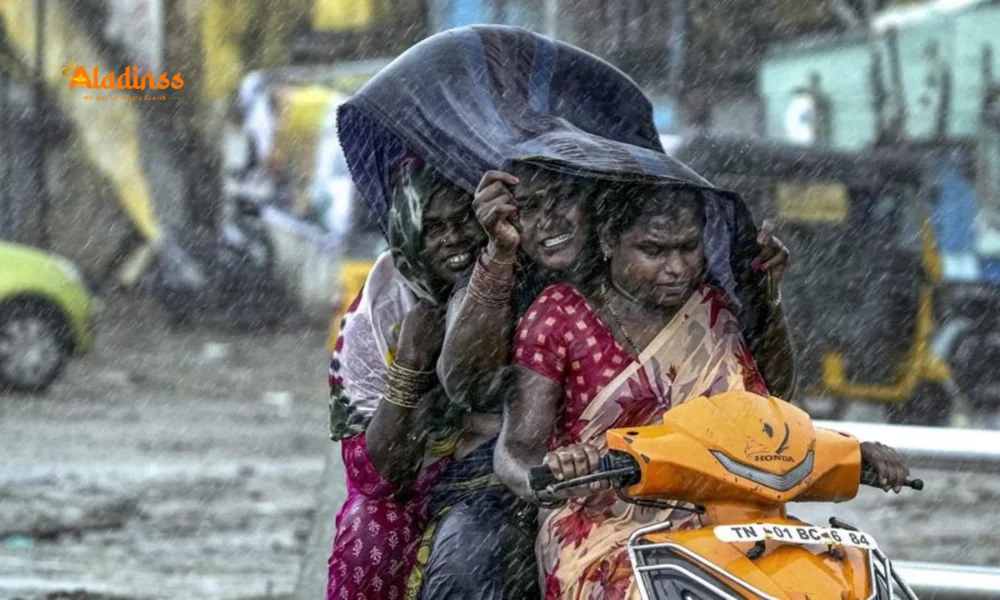Tamil Nadu Rain Alert: Heavy Rains in 7 Districts Today

Tamil Nadu Rain Alert: Heavy Rains to Lash 7 Districts Today, Warns IMD
The India Meteorological Department (IMD) has issued a critical warning for heavy rainfall across seven districts of Tamil Nadu today, September 6, 2025, as an atmospheric circulation over southern India triggers widespread showers. The affected districts—Thanjavur, Thiruvarur, Nagapattinam, Mayiladuthurai, Pudukkottai, Cuddalore, and Ariyalur—are expected to experience significant downpours, accompanied by thunder and lightning. This weather event is part of a broader pattern affecting North and South Tamil Nadu, Puducherry, and Karaikal, with the IMD also forecasting cyclonic storms in coastal regions, prompting a fishermen advisory. This article provides a detailed overview of the weather forecast, safety measures, and the potential impact on Tamil Nadu’s residents.
Tamil Nadu’s monsoon season in 2025 has been marked by fluctuating rainfall patterns, with coastal and delta districts receiving above-normal precipitation. The IMD’s latest alert highlights the influence of a low-pressure system and atmospheric circulation over southern India, driving intense weather activity. With Chennai and its suburbs also bracing for light to moderate rain, residents across the state are urged to stay vigilant and prepared for potential disruptions such as waterlogging, traffic snarls, and power outages.
Today’s Weather Forecast for Tamil Nadu
According to the IMD, an atmospheric circulation prevailing over southern India is responsible for the heavy rainfall expected today. The forecast indicates light to moderate rain with thunder and lightning at several locations in North Tamil Nadu, including Chennai, and at a few places in South Tamil Nadu, Puducherry, and Karaikal. Specifically, heavy rain is anticipated in Thanjavur, Thiruvarur, Nagapattinam, Mayiladuthurai, Pudukkottai, Cuddalore, Ariyalur, and Karaikal areas. These districts, primarily in the delta and coastal regions, are prone to flooding during intense monsoon spells, necessitating proactive measures from local authorities and residents.
In Chennai, the IMD predicts partly cloudy skies with light to moderate rain and thunderstorms at isolated locations. The maximum temperature is expected to range between 35–36°C, while the minimum will hover around 26–27°C. The city, a major hub with a history of monsoon-related challenges, is likely to face waterlogging in low-lying areas, prompting the Tamil Nadu government to deploy monitoring teams and ensure drainage systems are operational.
Forecast for the Coming Days
The IMD’s forecast extends beyond today, with heavy rainfall expected to continue in several districts over the next few days. On September 7, 2025, light to moderate rain with thunder and lightning is likely at a few places in North Tamil Nadu and isolated areas in South Tamil Nadu, Puducherry, and Karaikal. Heavy rain is predicted at one or two locations in Tiruvannamalai, Kallakurichi, Villupuram, Cuddalore, Mayiladuthurai, Trichy, Ariyalur, Perambalur, and Puducherry. This continued rainfall could exacerbate flooding risks in already saturated delta regions, particularly in districts like Cuddalore and Mayiladuthurai, which are also forecast to receive heavy showers today.
On September 8, heavy rain is expected at isolated locations in Ramanathapuram, Sivaganga, Pudukkottai, Thanjavur, Thiruvarur, and Nagapattinam. By September 9, the focus shifts to the hilly areas of Coimbatore, Nilgiris, Theni, Dindigul, Madurai, Sivaganga, as well as Ranipet, Vellore, Tiruvannamalai, Kanchipuram, and Chengalpattu districts, where heavy rainfall is likely at one or two places. This multi-day forecast underscores the widespread impact of the current weather system, affecting both coastal and inland regions of Tamil Nadu.
Cyclonic Storms and Fishermen Advisory
In addition to heavy rainfall, the IMD has warned of cyclonic storms impacting coastal regions. The southwest and adjoining west-central Arabian Sea, Gujarat coast, and northeast Arabian Sea are expected to experience cyclonic winds reaching speeds of 45–55 kmph, with gusts up to 65 kmph. Similarly, the north Maharashtra coast and adjoining east-central Arabian Sea may see winds of 40–50 kmph, gusting to 60 kmph. Closer to Tamil Nadu, cyclonic storms are likely to hit the southern parts of the southwest Bay of Bengal, the southern Tamil Nadu coast, the Kumari Sea areas, and the Gulf of Mannar.
Due to these hazardous conditions, the IMD has issued a strict advisory for fishermen, urging them not to venture into these areas today. The rough seas and high winds pose significant risks to small vessels, and the advisory aims to prevent accidents and ensure safety. Fishermen along the Tamil Nadu coast, particularly in districts like Nagapattinam and Ramanathapuram, have been instructed to secure their boats and avoid sea travel until conditions stabilize.

Potential Impacts and Precautionary Measures
The heavy rainfall forecast for Tamil Nadu is likely to cause significant disruptions, particularly in low-lying and flood-prone areas. Districts like Thanjavur, Cuddalore, and Nagapattinam, which are part of the Cauvery delta, have historically faced severe flooding during monsoon seasons. Waterlogging in urban centers, including Chennai, could lead to traffic congestion, delayed public transport, and temporary power outages. The Tamil Nadu State Disaster Management Authority (SDMA) has advised residents to avoid unnecessary travel during peak rainfall hours and stay indoors during thunderstorms to minimize risks from lightning and flooding.
Local authorities have been directed to coordinate with emergency response teams, including the National Disaster Response Force (NDRF) and State Disaster Response Force (SDRF), to prepare for potential rescue and relief operations. District collectors in the affected areas are monitoring reservoirs and drainage systems to prevent overflow and ensure timely water release. Residents are encouraged to report waterlogging or fallen trees to local helplines, such as Chennai’s 1913, for immediate assistance. Keeping emergency supplies like food, water, and flashlights ready is also recommended, especially in rural areas prone to power disruptions.
Safety Tips for Residents
To stay safe during this period of heavy rainfall, residents should take proactive measures. Avoid traveling through flooded areas, as even shallow water can pose risks to vehicles and pedestrians. If travel is unavoidable, use real-time weather apps or check updates from the IMD to plan routes. Secure loose objects around homes to prevent damage from strong winds, and ensure electrical appliances are unplugged during thunderstorms to avoid damage from lightning strikes. For those in low-lying areas, elevating valuables and moving to higher ground during heavy rain can prevent losses.
Farmers in the delta districts should monitor their fields for waterlogging and ensure proper drainage to protect crops. The IMD has advised against outdoor agricultural activities during peak rainfall hours. Additionally, residents should stay updated with local weather alerts through radio, television, or the IMD’s official website and social media channels. Enabling SMS alerts from local authorities can provide real-time updates on road closures or emergency services.
Impact on Agriculture and Water Resources
The heavy rainfall is expected to benefit Tamil Nadu’s agricultural sector, particularly in the delta regions, where reservoirs like Mettur, Bhavanisagar, and Veeranam have seen positive inflows due to recent rains. This could improve water availability for irrigation and drinking purposes in the coming months. However, excessive rainfall poses risks to standing crops, especially paddy, which is sensitive to waterlogging. Farmers are advised to consult agricultural extension officers for guidance on protecting crops and managing excess water.
The state government has also initiated cloud-seeding operations in some areas to manage water needs during the monsoon season. These efforts aim to balance the benefits of rainfall with the challenges of deficit areas, ensuring equitable water distribution. The Tamil Nadu Water Supply and Drainage Board (TWAD) is monitoring water levels in key reservoirs to prevent overflow and flooding in downstream areas, particularly in districts like Thanjavur and Nagapattinam.
Historical Context of Tamil Nadu Monsoons
Tamil Nadu’s monsoon history is marked by both opportunities and challenges. The northeast monsoon, which typically peaks between October and December, often brings heavy rainfall to coastal districts, while the southwest monsoon affects western districts like Coimbatore and Nilgiris. In recent years, extreme weather events, including cyclones like Fengal in 2024, have caused significant disruptions, with flooding in Chennai and delta districts leading to school closures and infrastructure damage. The current forecast, while not indicating a cyclone, highlights the need for preparedness given the state’s vulnerability to heavy rains.
The IMD’s accurate forecasting and early warning systems have improved significantly, enabling better coordination between state agencies and communities. However, public awareness and adherence to safety guidelines remain critical to minimizing losses. The government’s proactive measures, such as deploying NDRF teams and ensuring drainage maintenance, reflect lessons learned from past monsoon seasons, particularly the devastating floods of 2015 and 2021.
Comment / Reply From
No comments yet. Be the first to comment!











